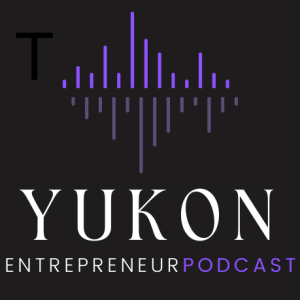
Saturday Jun 20, 2020
Teresa Vander Meer-Chassé | Upper Tanana Curator and Visual Artist | June 13, 2020
Join Yukon Entrepreneur Ddhälh kït Nelnah, Teresa Vander Meer-Chassé, member of White River First Nation as she talks about her business as an Upper Tanana Curator and Visual Artist.
(1:45) Teresa discovered her passion for art at a young age through music and learned beadwork from her grandmother. It was during her time in university studying Anthropology, as she struggled with a constant feeling of “othering,” that she took up beadwork to help with stress relief.
(3:55) As an entrepreneur, the pandemic is making Teresa feel vulnerable about her business. She’s been greatly affected by the pandemic with the cancellation of events. So for her this is a time to think about her next step and find new ways to present her work.
(5:15) Right as the pandemic hit, Teresa was about to reveal her latest curation at the Yukon Arts Center, Emerging North (https://yukonartscentre.com/events/emerging-north-exhibit). The team did a quick pivot and created an online video explanation and artist talk after having to cancel the grand opening of the exhibit.
(7:05) As a business leader, Teresa’s strength is as a natural teacher and she loves having engaging conversations with her audience and the artists she works with. Having conversations is what her business is all about and she uses her mediums of curation and visual art to find spaces of mutual respect and understanding. For herself, she’s focusing on growth and exploring new ways to express herself.
(9:25) In the face of all of the grief we’re collectively and individually experiencing Teresa has been changing her approach and lately she’s been focusing on making art for herself and her family.
(13:18) Teresa’s advice for emerging artists? Keep creating, keep creating, keep creating. You have an opportunity to engage with the arts community in a new way. Teresa’s goal as a curator is to include young Indigenous voices in gallery spaces because it’s a voice that is often missed.
(15:57) Teresa was naturally drawn to curation -- she grew up watching her Grandfather curate his collection in Beaver Creek at the museum he maintains there. For her, curation is about how people view something and how we play and manipulate space/things to convey a point of view. Her goal as a curator is to help portray the full expression of the artist's vision.
(18:50) There is a saying “that if you are born Indigenous, you are born political.” With the pandemic, the Black Lives Matter movement and Indgenous Rights, it is overwhelming at times. Teresa’s been using beadwork as her “bubble” to forget about all of the heaviness in the world right now. But she’s really thinking about this opportunity we have to move the conversation forward -- how and what are we going to change?
(21:35) Teresa’s aha moments these days? We’re dealing with a lot of big issues stacked on top of each other right now. She calls it “cultural exhaustion” -- where there is an expectation that because of who you are you are asked or compelled to respond to the moment. It’s an exhausting experience as an Indigenous woman. So for Teresa it’s about consciously taking time for herself to step away from it all and bead and ‘be in the moment.’ And when she takes that for herself she’s able to see the good in everything that is happening -- the celebration, the excitement and the change.
(24:00) Teresa’s hope for the Yukon’s economic renewal as we emerge from the pandemic? That we move away from Indigenous art being a checkbox or commodification and that we open ourselves to really hearing and respecting the voices of our artists. She sees that we are slowly moving in that direction as a territory. Right now is a great time for us to rebuild -- many of us are in the process of rebuilding our lives, our identities and our businesses.
(26:20) Ever the curator, Teresa shares three books for us to consider: Indian Horse by Richard Wagamese; The Marrow Thieves by Cherie Dimaline; and, Beyond Blood by Pamala Palmater. With each book, she speaks to how it impacted how she thinks about her worldview.
(29:20) Through her work with Indigenous and non-indigenous artists she sees that there is a fundamental difference in worldviews. For her, she can see it in how she was raised -- the words that were said and the lessons passed on by her grandparents. She acknowledges that it’s very difficult to explain those differences. For her, it’s about the integral connection between Indigenous people and the land.
No comments yet. Be the first to say something!